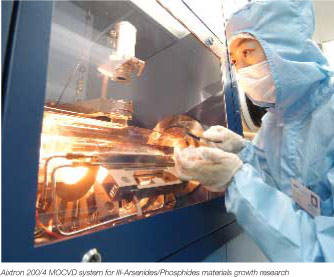Research Progress
Advanced Materials for Micro- and
Nano-Systems(AMM&NS) programme
In the AMM&NS programme, the emphasis is on developing an understanding of the selection, processing and property-optimisation of a wide array of materials and material combinations. The new materials and technologies will facilitate the development of microand nano-systems of ultra-high performance, consisting of electronic and optoelectronic devices for application in information transmission, processing, storage and electromechanical actuation.
Currently, the AMM&NS programme has twenty-two Ph.D. students and has graduated twelve M.Eng. students. The research topics include the use of heteroepitaxial SiGe films on Si substrates for fabrication of multi-mode interference optical filters. The application of strained Si films on SiGe substrates are also under investigation for the fabrication of CMOS devices. Silicidation processes of Ni on SiGe films have been examined for future metallisation on devices fabricated on such substrates. Research is being carried out on circuit-level assessments of the reliability of advanced metallisation technology for 0.1 and 0.18micron technologies, including Cu-based metallurgies and low-k dielectric materials. The development of processes for the growth of piezoelectric (PZT) films on Si microelectromechanical devices to serve as “active” materials for actuation is also under investigation.Metallic glasses obtained through rapid quenching from melt as well as their applications in high frequency cores in electronics and as the electrolyte medium and electrodes for high
power and energy density rechargeable micro-batteries, are also being studied. New projects on the role of graded InGaN buffers for strain relaxation in InGaN/GaN epilayers, the growth of germanium nano-crystalsand their applications in electronic devices, dislocations and their effects on the electroluminescence and photoluminescence emissions of IIINitrides and in micro-cavity LEDs and lasers as well as the structural evolution of growth of III-nitrides on silicon are currently underway.
The successful research and co-supervision collaborations involved both Singapore and MIT faculties and students who have common research interests as well as complementary expertise and capabilities. This has led to more than 25 joint publications in premier journals and award-winning research by SMA students. Most importantly, it stimulated regular interaction through video conferencing and on-site visits, not only among supervisors and students, but with other members of their extended research groups in Singapore and Cambridge. These collaborations have also grown to include research institutes and industry in both Singapore and the United States.





